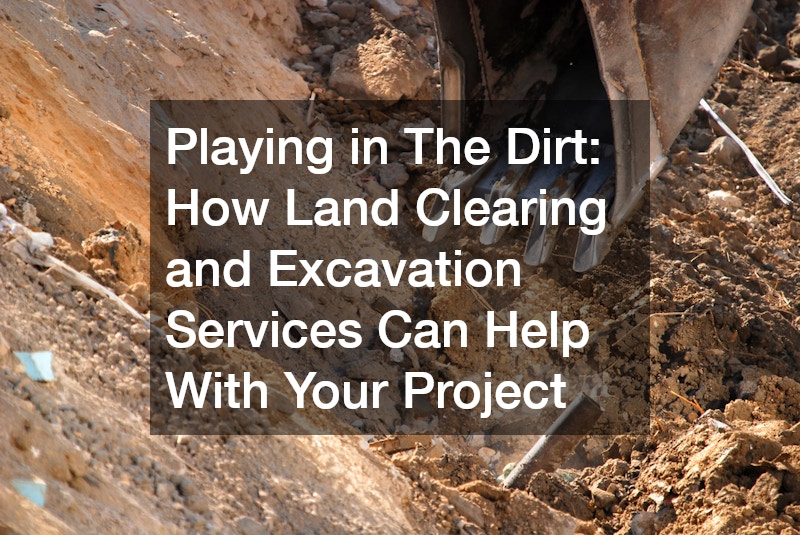Land clearing and excavation are essential components of many construction, landscaping, and development projects. These services transform raw or overgrown land into usable, safe spaces, ensuring the foundation for future work is solid. From residential developments to commercial construction, understanding how land clearing and excavation work, the associated costs, environmental considerations, and the right service providers can greatly influence the success of a project.
What is Land Clearing and Why is it Important?

Definition of Land Clearing
Land clearing is the process of removing trees, vegetation, brush, rocks, and other obstacles from a plot of land to make it suitable for construction, landscaping, or development. This preparation often goes beyond mere removal of visible objects and can include grading, leveling, and addressing soil conditions to ensure the land is ready for building or recreational use.
Benefits of Land Clearing
Proper land clearing offers numerous benefits. It improves safety by removing hazardous trees or uneven terrain that could cause accidents. It also enhances project efficiency, allowing construction crews and landscapers to work without interruptions from natural obstacles. Land clearing can improve property aesthetics and open opportunities for development, whether for a residential home, a commercial building, or even recreational spaces. Utilizing professional land clearing services ensures that these benefits are achieved efficiently and safely.
Environmental Considerations
While clearing land is often necessary, it has environmental implications. Removing trees and other vegetation can affect local wildlife habitats and disrupt ecosystems. Sustainable land clearing practices, such as selective tree removal, preserving critical vegetation, and soil management, help minimize environmental impacts. A tree removal company often works alongside land clearing services to carefully manage which trees are removed and how debris is handled, balancing project needs with ecological responsibility.
Land Clearing Methods
Land clearing methods vary depending on the size of the project and the type of terrain. Manual clearing involves hand tools and small machinery, ideal for smaller or sensitive areas. Mechanical clearing, commonly performed by local excavating contractors, uses heavy equipment like skid steers, bulldozers, and mulchers to clear large tracts of land quickly and effectively. In specific cases, controlled burning or chemical treatments may be employed, though these require strict adherence to local regulations and safety protocols.
Safety Measures in Land Clearing
Safety is critical in land clearing projects. Workers must use personal protective equipment and follow strict operational protocols. Areas should be clearly marked to avoid accidents, and operators must be aware of potential hazards such as uneven terrain, underground oil tanks, or unstable trees. Employing professional services ensures that safety measures are followed rigorously, reducing risk to both workers and property.
How Does the Excavation Process Work?
Basic Steps in Excavation
Excavation involves moving earth to prepare a site for foundations, sewer lines, landscaping, or other construction projects. Basic steps include surveying the site, marking boundaries, removing topsoil, digging to the required depth, and sometimes installing temporary supports. Each step requires precision to prevent structural issues or delays.
Types of Excavation
Excavation comes in various forms. Trench excavation is essential for sewer taps and sewer line replacement projects. Foundation excavation ensures a stable base for buildings, while grading and cut-and-fill excavation reshape the land to desired contours. Each type serves a specific purpose and requires appropriate planning and equipment.
Equipment Used in Excavation
Excavation relies heavily on specialized machinery. Skid steers, excavators, backhoes, bulldozers, and dump truck service are commonly used for moving large volumes of soil and debris. Advanced machinery with GPS and laser-guided systems improves accuracy and reduces the likelihood of errors. Local excavating contractors often have a fleet of these machines to handle projects of all scales.
Challenges in Excavation Projects
Excavation projects can face several challenges. Unexpected underground obstacles such as buried oil tanks, utility lines, or rock formations can slow progress and increase costs. Soil instability, water accumulation, and weather conditions also pose risks. Experienced local excavating contractors anticipate these challenges through careful site surveys, soil analysis, and contingency planning.
Site Preparation for Excavation
Proper site preparation is crucial for a smooth excavation process. This includes clearing debris, marking boundaries, identifying underground hazards like oil tanks or old sewer lines, and setting up erosion control measures. Thorough preparation allows excavation and subsequent construction or landscaping work to proceed efficiently and safely.
What are the Costs Associated with Land Clearing and Excavation?

Factors Influencing Costs
Costs vary depending on property size, vegetation density, terrain, soil type, and accessibility. Projects in remote areas or those requiring extensive tree removal or sink hole repair will be more expensive. Additionally, specialized services such as sewer line replacement, underground oil tank removal, or plumbing service installations can add to overall project costs.
Typical Pricing Models
Contractors often use different pricing approaches. Per-acre pricing is common for large land clearing projects, while hourly rates or project-based quotes are typical for excavation work. Understanding these models helps property owners budget effectively and compare service providers.
Cost-Saving Tips
Efficiency and planning can reduce costs. Hiring a combined team of land clearing services and local excavating contractors can prevent duplication of work. Properly scheduling tree removal, debris disposal through dump truck service, and excavation phases reduces downtime. Additionally, tackling minor maintenance like plumbing service installations simultaneously with excavation can avoid future disruptions.
Budgeting for Large Projects
Large-scale projects require careful budgeting. Account for labor, machinery, permits, debris disposal, and specialized services like sewer taps or sink hole repair. Contingency funds should also be set aside for unexpected findings such as underground oil tanks, soil instability, or unforeseen debris.
Dealing with Unforeseen Expenses
Unanticipated issues can arise during land clearing or excavation. These might include hazardous trees requiring specialized removal, damaged sewer lines needing replacement, or discovering underground oil tanks. Working with experienced contractors ensures that these situations are addressed efficiently, minimizing delays and additional costs.
How to Choose the Right Land Clearing and Excavation Service?
Essential Qualifications and Experience
Selecting the right service is crucial. Look for contractors with extensive experience in both land clearing services and excavation. A tree removal company with knowledge of safe vegetation management and local excavating contractors skilled in handling heavy machinery will ensure quality results.
Questions to Ask Potential Contractors
When vetting contractors, ask about their experience with specific services like sewer line replacement, sink hole repair, and underground oil tank removal. Inquire about equipment availability, such as skid steers and dump truck service, and request examples of completed projects.
Evaluating Customer Reviews
Customer feedback provides insight into a contractor’s reliability, safety practices, and quality of work. Positive reviews highlighting professionalism, adherence to schedules, and effective problem-solving are strong indicators of a trustworthy service provider.
Importance of Licensing and Insurance
Licensing ensures compliance with local regulations, while insurance protects property owners from potential liability. Contractors handling excavation or land clearing must be insured for equipment damage, worker injuries, and environmental hazards.
Comparing Quotes and Services
Obtain multiple quotes and compare services offered. Look beyond pricing to evaluate the scope of work, equipment used, and experience with specialized services like plumbing service installations, sewer taps, or sink hole repair. A comprehensive quote that addresses all project needs reduces the likelihood of unexpected expenses.
What Role Does Land Clearing Play in Construction Projects?

Preparing the Site for Construction
Land clearing services prepare the ground for construction by removing vegetation, debris, and obstacles. Proper site preparation allows builders to lay foundations efficiently, ensures accurate grading, and reduces the risk of delays due to uneven or obstructed terrain.
Land Grading for Foundations
Grading is essential for stable foundations. Excavation ensures that soil is properly compacted and leveled, preventing structural issues. Contractors often coordinate grading with sewer line replacement or other underground utilities to streamline the project.
Impact on Project Timeline
Efficient land clearing and excavation can significantly reduce project timelines. Delays in removing trees or preparing the site often cascade into later construction phases. Coordinating services such as tree removal, skid steers usage, and dump truck service for debris transport keeps the project on schedule.
Coordination with Other Contractors
Land clearing and excavation often involve coordination with plumbers, landscapers, and utility contractors. Early integration of sewer taps, sewer line replacement, or plumbing service ensures a seamless workflow and prevents rework.
Environmental Sustainability Practices
Modern land clearing services incorporate eco-friendly practices, such as selective tree removal and debris recycling. Sustainable excavation practices minimize soil erosion, protect water quality, and reduce the impact on surrounding ecosystems.
Are There Environmental Impacts of Land Clearing and Excavation?
Potential Impact on Local Ecosystems
Removing vegetation and soil disturbance can disrupt habitats for wildlife and reduce biodiversity. Projects should balance development needs with environmental stewardship to maintain ecosystem health.
Soil Erosion and Sedimentation Concerns
Excavation and land clearing can expose soil to erosion and sedimentation, which may affect water quality in nearby streams or rivers. Implementing erosion control measures and using professional land clearing services mitigates these risks.
Mitigating Negative Environmental Effects
Contractors can employ strategies like retaining natural vegetation buffers, replanting trees, and managing debris responsibly. A tree removal company often assists in selective removal to minimize ecological impact.
Regulatory Compliance and Permitting
Local regulations often require permits for land clearing, excavation, and underground work like sewer line replacement or oil tank removal. Compliance ensures legal operation and reduces the risk of fines or project shutdowns.
Innovations in Eco-Friendly Practices
Eco-friendly excavation and land clearing methods continue to evolve. Techniques such as using skid steers for precise vegetation removal, recycling debris through dump truck service, and minimizing soil disruption reflect a commitment to sustainability.
How are Tree and Vegetation Removal Managed?
Techniques for Safe and Efficient Tree Removal
A professional tree removal company uses specialized equipment and strategies to safely remove trees. Techniques include controlled cutting, stump grinding, and debris management to minimize hazards and property damage.
Handling of Debris and Waste
Debris from land clearing is often managed through dump truck service, which transports vegetation, rocks, and other materials off-site. Proper disposal or recycling prevents environmental contamination and maintains site cleanliness.
Replanting and Landscaping Options
After clearing, landscaping and replanting can enhance aesthetics and restore environmental balance. Contractors may offer replanting services or collaborate with landscapers to create functional and attractive spaces.
Role of Arborists in Land Clearing
Arborists provide guidance on tree health, species preservation, and proper removal methods. Their expertise ensures that tree removal is conducted safely and responsibly, aligning with environmental considerations.
Legalities of Tree Removal
Many areas have legal restrictions on removing certain trees, requiring permits or adherence to local ordinances. Working with a licensed tree removal company ensures compliance with regulations.
What Permits are Required for Land Clearing and Excavation?
Understanding Local Regulations
Local regulations dictate what permits are required for land clearing, excavation, sewer taps, or underground oil tank removal. Knowledge of these rules prevents legal complications.
Navigating Permit Application Processes
Permit applications often involve submitting site plans, environmental assessments, and project details. Contractors can assist in completing these applications to avoid delays.
Common Permits Needed
Typical permits include land disturbance permits, tree removal permits, and excavation permits. Specific projects, such as sewer line replacement or sink hole repair, may require additional approvals.
Fees and Timelines for Permit Approval
Permit fees and approval timelines vary by jurisdiction. Planning ahead ensures that projects remain on schedule and reduces the likelihood of costly hold-ups.
Consequences of Non-Compliance
Failure to obtain proper permits can result in fines, project shutdowns, or legal liability. Engaging experienced contractors reduces these risks and ensures smooth project execution.
How Can Land Clearing and Excavation Enhance Property Value?
Transforming Raw Land into Usable Space
Clearing and excavation transform overgrown or uneven land into usable space for building, landscaping, or recreational use. This transformation directly increases the property’s functional value.
Improving Lot Aesthetics
Proper land clearing and tree removal improve the visual appeal of a property. A well-maintained lot attracts buyers or tenants, enhancing marketability.
Increasing Marketability
Developed and cleared land appeals to developers and investors. Services like sewer line replacement, sink hole repair, and plumbing service installations further increase the attractiveness of the property.
Creating Opportunities for Development
Cleared and graded land provides flexibility for residential, commercial, or recreational development. Access to skilled local excavating contractors ensures that complex projects, including underground work, are feasible.
Long-Term Investment Considerations
Investing in land clearing and excavation is not just about immediate utility—it’s a long-term strategy. A well-prepared site reduces maintenance costs, ensures safety, and increases resale or development value over time.
What Safety Protocols are Followed in These Services?

Identifying Site Hazards
Professional contractors assess potential risks such as unstable trees, sink holes, underground oil tanks, and uneven terrain before beginning work.
Personal Protective Equipment (PPE)
Operators and workers wear PPE, including helmets, gloves, eye protection, and high-visibility clothing. Safety protocols extend to monitoring machinery and the work area.
Training and Certification for Operators
Skilled operators of heavy equipment, such as skid steers and excavators, undergo thorough training and certification. Competence reduces accidents and ensures adherence to industry standards.
Emergency Response Plans
Comprehensive safety planning includes protocols for emergencies, including injury response, equipment failure, or environmental hazards like exposed underground oil tanks.
Ongoing Safety Inspections and Audits
Regular inspections, equipment checks, and audits ensure ongoing safety. Professional land clearing and excavation companies maintain these practices to protect workers, property, and the surrounding environment.
Closing Thoughts
Land clearing and excavation services play a vital role in transforming raw land into safe, usable, and valuable spaces. From tree removal and skid steers to sewer line replacement and underground oil tank management, professional services ensure efficiency, safety, and environmental responsibility. By understanding the processes, costs, and best practices involved, property owners and developers can achieve successful project outcomes, enhance property value, and create a foundation for future development.


